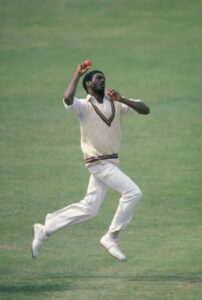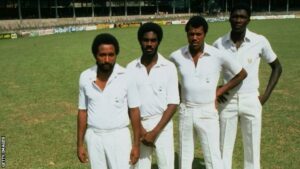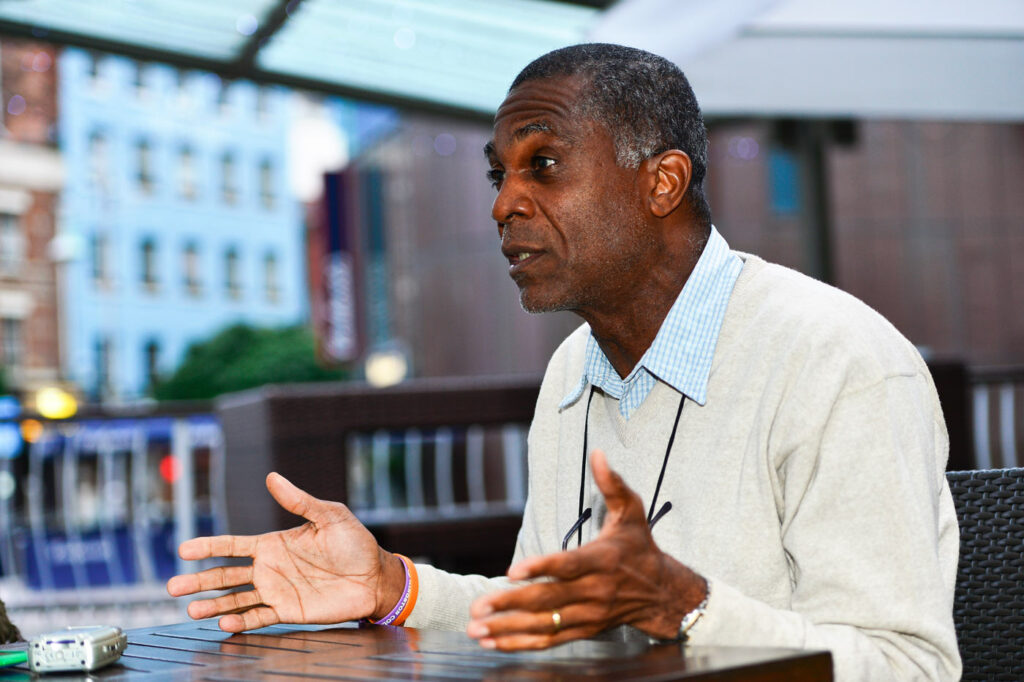Michael Anthony Holding made his first-class debut for
Jamaica in 1973 as a nineteen-year-old teenager and his
Test debut just two years later at Brisbane during the 1st
test of the WI 1975-76 Tour of Australia. Mikey Holding, as he is
now universally and fondly known, eventually went on to capture
249 Test wickets in just 60 matches at an incredibly admirable
average of 23.68, becoming in the process one of the undisputed
greats of Caribbean cricket.
Holding’s progression, from a gangly 6 six foot four-inch teenager
to the highest heights of international cricket, was at all times
fueled simply by his passionate love and desire to be actively
involved in any and all sports, including cricket.
“I have been involved with sport including cricket from the time I was a kid. I played my first officiated game of cricket, with an umpire involved, at age 10. My little home area, Dunrobin Avenue, had a team that played in the Rankine Cricket Cup, and one weekend when they had invited me to play that was the very first time I’d been in a match
that had an umpire. That was also the match for which my sister had bought me my first cricket trousers, a “fancy dress pants! ”
Holding’s interest in fast bowling specifically, was developed
directly as a result of the neighborhood cricket, he played as a
kid. Initially, he used to try to do everything bat and bowl. In the
type of cricket he and his fellow neighborhood kids played though,
“ketchy shubby” as the game was called, the only way you could get a
chance at bat was if you either caught the batsman out or bowled them out yourself.
Further, there were no umpires present so the only way you could get
a batsman out bowled was to make sure that they weren’t using their legs as a shield to prevent the ball from hitting the stumps. “That attracted me to bowling fast for I knew that if I hit them on the legs the
next time I ran in they wouldn’t be wanting for that to happen again! That was the very first incentive I received to become a fast bowler!
Graced with one of the smoothest, most beautifully graced run-ups international cricket has ever seen, Holding says that it was just simply his very natural way of running. He doesn’t even recall ever having
to measure his run-up initially. He just ran at the pace and the distance from the stumps that seemed most natural.
The actual distance was, however, very much influenced by the fact in street cricket there were oftentimes as many as three or four others with balls waiting on their chance to bowl and no specified order dictating who would be next either. As such you couldn’t afford to take too long a run if you wanted to bowl as often as possible so as to give yourself the best chance of getting batsmen out. The resulting formula for him was just having the exact number of steps that
would allow him to bowl as quickly as possible.
Incredibly Holding never held any ambitions of eventually becoming a West Indies cricketer. Initially, he played his cricket as he did all the other sports with which he was involved simply for the pure
enjoyment he derived from doing so and “because it was there to be played!”
By the time he was a teenager he had also begun playing for the Melbourne Cricket Club. His father had been a Melbourne Member for donkey years before Mikey was even born. It wasn’t a surprise to anyone, therefore, that his father had Mikey also registered as a Melbourne Member just a soon as he was born!
It was at Melbourne that Mikey was presented with the opportunities to play regular cricket against those who were many years his senior. Melbourne back then used to play regular Sunday “Curry
Goat” friendly matches against the bauxite companies and other rural out-of-city teams, for which Mikey with his rapidly developing fast bowling skills soon became a fixture.
He also played Minor Cup cricket for Melbourne and had actually played representative cricket for the club before he’d done so for his school. It was only after the school’s Coach had heard of Mikey playing for Melbourne that an invitation was subsequently issued for him to also do so for his school.
At the time within Jamaica’s established Club cricket system, there were at least four levels of competitive matches. Minor, Junior, and
Senior Cup were the three formal levels of available cricket to which the Sunday Curry Goat matches added an informal fourth level.
For a developing talent such as Mickey Holding was, whether or not he
had any such aspirations there was definitely a clearly identified and
available pathway for his progression to the highest level of Jamaican cricket.
At school, there were also three available levels of cricket. Junior Colts
for the youngest students, Colts for those aged under 16, and finally the Sunlight Senior Cup for all those school cricketers, who were
the most talented, regardless of age.
Mikey’s Colts captain was Sidney Headley, a son of the famous
Jamaican and West Indies Test cricketer George Headley, who also played Sunlight cricket simply because he was good enough to do so.
There were, therefore “many avenues to get into cricket” during Mikey Holding’s schoolboy days!
Mikey’s meteoric rise through the various levels of Jamaican cricket was again not fueled by anything other than his love for the game and the enjoyment that playing provided. Not long after he started playing
for his school he was called to trials for the Jamaican U19 team that would be participating in the 1971 Benson & Hedges Caribbean U19 Tournament, as a mere seventeen-year-old. He represented the National U19 team during Jamaica’s hosting of the 1971 Benson & Hedges U19 Championships, then made his very first overseas tour to Barbados the following year for the Tournament’s 1972 edition.
Holding’s performances in the 1973 Benson & Hedges Tournament, hosted by St Lucia, were good enough to warrant his inclusion to Jamaica’s Shell Shield Squad. He was also that year included in both the West Indies U19 and President’s XI for their respective
matches against the visiting Ian Chappell lead Australian Test squad.
1973 was also the year that Holding made his first-class debut for Jamaica and by then his prodigious talents as a fast bowler had become palpably obvious to many. So much so that questions were even being asked of the Jamaican Team’s Manager and West Indies Selector, JK
Holt, as to whether he should not also be included in the West Indies team to England for the 1973 summer series that was to immediately follow the Australian’s visit to the Caribbean.
Even amidst all the excitement of his meteoric rise through the U19 ranks and into the Jamaican National Senior team, Holding still wasn’t harboring any ambitions of making cricket his career. He’d started working in Jamaica at the Barclays Bank and his inclusion to the
National Team for its overseas 1973 Shell Shield “Away” Matches required him to ask the Bank’s Manager for the necessary time off to do so.
The Bank Manager’s response was to advise Holding that he would have to choose between cricket and his banking career. As fate would have it, Holding’s lack of any real financially binding responsibilities at the time, choose cricket, again simply because he was enjoying playing the game that much.
His choice was in stark contrast to that of his much senior Jamaican fast bowing teammate, Rudolph Cohen, who having been given the exact ultimatum chose instead to relinquish his cricket career in
deference to continuing his employment at the bank.
 Holding was eventually selected to the West Indies Squad for its 1975-76 tour of Australia, By then the realization had dawned on him that Test cricket would require a much higher level of personal fitness.
Holding was eventually selected to the West Indies Squad for its 1975-76 tour of Australia, By then the realization had dawned on him that Test cricket would require a much higher level of personal fitness.
During his debut appearance for Jamaica, the captain Maurice Foster
had given him the new ball. Being fresh out of school and wanting to impress the large Sabina Park crowd present, he ran in as quickly as he could. By the time he’d finished his fourth over on the trot however he was “dog tired,” almost completely exhausted, and wishing desperately that Skipper Foster wouldn’t throw him the ball asking him to bowl
another over.
That experience helped him to appreciate the association between fitness and fast bowling. More importantly, it also helped him to realize how far behind the required levels of fitness he was personally! Even
before his selection for the West Indies Tour to Australia, he’d started running more and had also begun going to his old school Kingston College (KC) regularly to do some weight training under the watchful supervision of Mr. Goldsmith, known to all as “Mr.G”as a means of
becoming stronger.
“I did gym training. I lifted weights to get strong, but at the same time I did a lot of running. One without the other doesn’t make sense.You can be strong but you can be unfit even if you are strong, because you need to be running. You can’t just stand up at the crease and bowl fast. You have to be able to run to the crease to bowl fast. In the gym, lifting weights is not going to help you do that.”
“I didn’t do a lot of bowling in the nets. I bowled a little bit, obviously, but I was more interested in running. I did a lot of running, especially after Dennis Waight came into the West Indies set-up. He had the fast bowlers running uphill, downhill, through the stands, up the steps, everything. Because you had to have strong legs. Because you are going
to be running a lot when you are bowling.
Yes, I went to the nets and bowled, but not over after over after over. I would perhaps bowl a five-over spell at the top of the innings to whoever is batting – Greenidge or Haynes. Perhaps later on I would come off a few steps and bowl again. I wouldn’t bowl
His attitude towards needing to be as fit as possible didn’t change, however until the 1977 World Series and Dennis Waight’s associated official appointment as the West Indies Fitness Trainer. Waight took
the fitness levels of Holding and his fellow initial “fearsome foursome” fast bowlers: Andy Roberts, Joel Garner, and Colin Croft to a different, much higher level altogether.
He routinely took them on “serious much faster than jogging” runs at least once, oftentimes twice, each and every day. Waight also had them constantly engaged in stretching and strengthening exercises. As a result, the fitness levels of Holding and his fellow fast bowlers were stepped up quite a few levels as a consequence of Waight’s training
